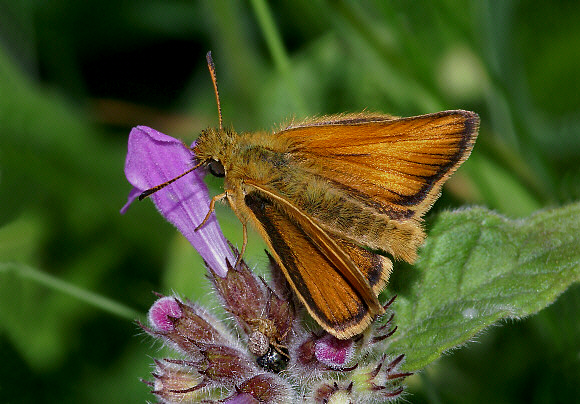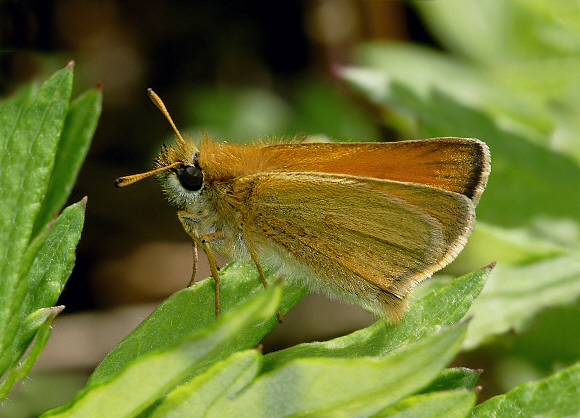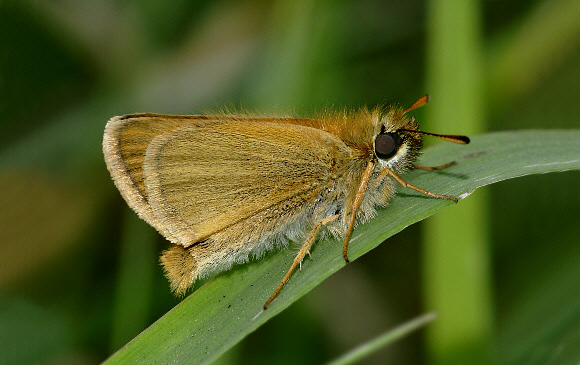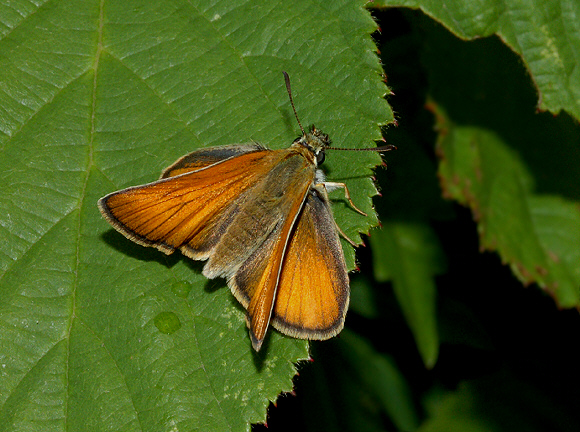 Thymelicus lineola Note the tiny crab spider lying in wait on the flower! – Adrian Hoskins
Thymelicus lineola Note the tiny crab spider lying in wait on the flower! – Adrian Hoskins
 Essex Skipper Thymelicus lineola, Farlington Marshes, Hampshire – Adrian Hoskins
Essex Skipper Thymelicus lineola, Farlington Marshes, Hampshire – Adrian Hoskins
Introduction
The Essex Skipper is a very common and widely distributed species in Europe, occurring throughout the region with the exceptions of Sardinia and northern Scandinavia. It’s range extends eastward across Asia from Turkey to Amurland. In Africa it is common north of the Sahara, particularly on the Mediterranean coast of Morocco and Algeria.
The butterfly was accidentally introduced into Canada in 1910, and within a few decades had spread across much of North America where it is known as the European Skipper. It is believed that the major cause of this expansion was the transportation of hay bales – in one study over 5000 lineola eggs were found in a single bale.
It is easy to confuse this butterfly with the Small Skipper Thymelicus sylvestris which often shares the same habitats. In sylvestris the band of androconial scales is prominent and runs diagonally. The tips of the underside of its antennae are orange or dark reddish. In lineola however the band of dark androconial scales on the forewings of the male is very narrow and runs parallel to the costa, and the tips of the underside of the antennae are glossy black. The simplest way to find out which of these 2 species are present at a site is to visit just before dusk, when the butterflies will be sitting quietly on grass stems. They can then easily be examined without resorting to capture.
Habitats
The Essex Skipper has always been under-recorded due to its similarity to the Small Skipper, so its distribution, particularly in former times, is poorly understood. In Britain it was first discovered in 1888 in Essex, and for many years it was thought to be restricted to south-east England. In truth it has probably always occurred over a much wider area, but equally there is little doubt that it is now far commoner and more widespread than in earlier times.
It is likely that during periods when rabbit grazing was a major problem the butterfly was relatively scarce, but that when myxomatosis caused rabbit numbers to dwindle in the 1950’s it began to spread rapidly. It is also believed that expansion of the road network, particularly the advent of motorways, instigated further colonisations, as Essex Skippers are commonly found breeding on the dry grassy embankments, which form a man-made migration corridor.
Whatever its history, the species is now common and widespread on rough grassland throughout much of central and south-eastern England, with smaller isolated colonies in Dorset, Devon and Cornwall.
 Essex Skipper Thymelicus lineola, female, Farlington Marshes, Hampshire – Adrian Hoskins
Essex Skipper Thymelicus lineola, female, Farlington Marshes, Hampshire – Adrian Hoskins
The butterfly is commonest at ungrazed habitats where grasses grow tall but fairly sparsely, and it generally prefers drier habitats than its close relative sylvestris. Typical habitats of lineola include roadside verges, motorway embankments, railway cuttings, field headlands, sand dunes, coastal grasslands and undercliffs. At grazed sites it breeds mainly along the base of hedgerows or close to bushes – areas which rabbits and domestic livestock tend to avoid. Thus scrubby grassland sites tend to have stronger populations than more open habitats.
 Essex Skipper Thymelicus lineola, female, Farlington Marshes, Hampshire – Adrian Hoskins
Essex Skipper Thymelicus lineola, female, Farlington Marshes, Hampshire – Adrian Hoskins
Lifecycle
The butterflies emerge slightly later than the Small Skipper, in mid-late July.
The eggs, which are lozenge-shaped and milky white in colour, are laid in strings of 3 or 4, inserted into the flower sheaths of cocksfoot Dactylis glomerata, creeping soft grass Holcus mollis, timothy Phleum pratense, and tor grass Brachypodium pinnatum, but never on Yorkshire fog grass Holcus lanatus, the main foodplant of the Small Skipper. The eggs are laid in late July, and by early August the tiny caterpillars are fully developed within, but do not hatch until the following April.
The caterpillars live within a shelter made by rolling a blade of grass into a tube, which is held together with strands of silk. It hides within the tube during the daytime, and feeds at dusk, although fully grown caterpillars can sometimes by found basking in full sunlight on grass blades.
The chrysalis, which is thin, green, and has white palpi, is formed within a very loose shelter constructed by spinning together rolled grass blades, at the base of a tussock.
 Essex Skipper Thymelicus lineola, female, Stansted Forest, West Sussex – Adrian Hoskins
Essex Skipper Thymelicus lineola, female, Stansted Forest, West Sussex – Adrian Hoskins
Adult behaviour
The adults usually occur in sizeable colonies, where populations may run into hundreds or thousands of individuals.
In common with most other grass-feeding skippers, the butterflies have a rapid, buzzing, purposeful flight, “skipping” from flower to flower. They nectar at a wide range of wild flowers including small scabious, thistles, knapweed, red clover, white clover, marjoram, ox-eye daisy, wild mignonette, thyme, tufted vetch, self-heal, betony, ragwort, yarrow, fleabane, wild basil, hedge bedstraw and bird’s foot trefoil.
In overcast weather they are inactive, but in hazy sunlight they spend long periods basking, in the characteristic Hesperiine posture, half hidden amongst tall grasses. In hot weather they commonly settle with their wings fully closed, usually on grass flowerheads or high on the stems.
As dusk approaches, Essex and Small Skippers migrate to sheltered sunlit areas of tall grasses, where they sometimes roost in hundreds, often with 2 or 3 individuals sharing a single grass head. At this time it is easy to approach the insects, and the ideal time to examine them in determine which of the 2 species are present, and in what ratio.
